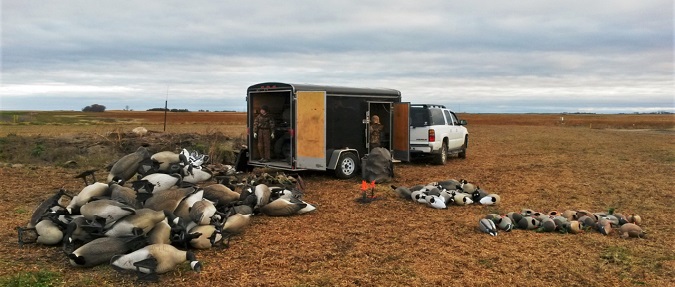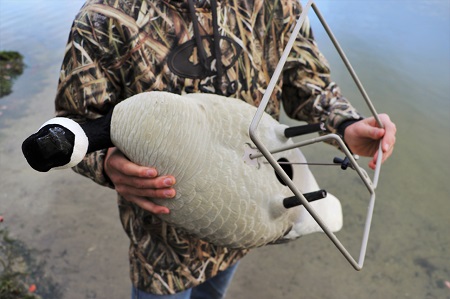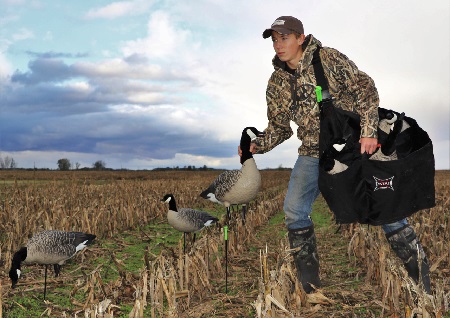As budding waterfowlers in the 1980s, my brother and I were gifted a dozen goose shells. We were severely ill equipped by today’s standards, but it didn’t matter much. The Canada goose season was short and the daily bag limits were low. Operating from the middle of the then perpetually not doing well Southern James Bay Population’s wintering area, we just didn’t have much opportunity to truly grind it out and earn our stripes as goose hunters.

Then everything changed.
Local Canada goose populations grew. Long, special nuisance seasons offered liberal daily bag limits and provided hunters with great opportunity.
The old adage necessity is the mother of invention is perhaps no truer than when discussing waterfowl hunting. I don’t recall him doing it on the show, but I’d bet Angus “Mac” MacGyver was a waterfowl hunter. Some of us did MacGyver-like things: like turn field shells into floaters with pipe insulation. Others cut the bottoms out of old floaters to make field shells. And there were even more desperate acts.
During my college years, a friend and I made goose field decoys out of chicken wire, old bed sheets and a discarded sheet of plywood. They worked pretty well… unless it was raining… or windy… or the ground was frozen.
A new era
Most goose hunters are never truly satisfied with their decoy inventory. Thankfully, a new era of decoys is upon us. It’s never been easier to deploy astonishingly realistic decoys quicker, more affordably, and with less concern for major maintenance issues. Whether new to the game or simply upgrading, investing in some really good decoys is economically doable for just about any goose hunter. But there are several important things to take into account when building a goose spread.
How much?
Economics remain a primary concern for most hunters. How much are you willing to spend? Answer this question honestly, unless you’re prepared to call a divorce attorney the day your spouse looks over the joint bank statement.
If you’re on the ramen noodle budget like so many young new hunters, consider teaming up with a hunting partner or two to lessen the burden on your wallet. But be forewarned: The more owners those decoys have, the more difficult it might become to actually get your hands on them. Plus, your partners will beat the crap out of them, cover them with mud and cow poop, and then drop them off at eleven o’clock on Friday night before the morning’s big hunt; so think things through.
 How many?
How many?
While most us dream of a trailer full of the best decoys at our sole disposal, truth is, it isn’t usually necessary to have more than three or four dozen in a variety of poses. Most hunters who invest in a mountain of full-body goose decoys typically only use a portion of them. Local geese, in particular, regularly respond well to smaller spreads, so you probably don’t need as many as you think.
If you have the financial means to punch your dream decoy ticket all at once, great. If not, think long term and purchase as many of the best decoys you can afford. Hunts can always be tailored to accommodate the size of your spread. Buy more when possible. Since you started out with the good stuff, you can rest assured that upgrading and significant maintenance won’t be immediate issues.
Storage
Until you’ve unloaded four-dozen bulky goose decoys out of a garage attic and shoved them into an SUV, it’s hard to truly appreciate the space full-bodies command. Pay attention to decoy dimensions, because bigger isn’t always better. What kind of bases do they have? Decoys with attached or separate bases add to the headache. Retractable motion-bases like those used by Avian-X are the best option when it comes to maximizing space, storage and convenience when setting out and picking up the spread. If space is a concern, build the bulk of your spread with lesser full-bodies and stackable shells.
Size
While many hunters feel larger decoys are more visible at a distance, for the most part they’ll appear just as good as smaller-sized decoys. Geese have poor depth perception. For this reason – and for the space and storage considerations already discussed – many experienced goose hunters have made the switch to smaller, lesser Canada goose decoys, even in areas where small race geese are unusual. For most, using a spread comprised largely of amazingly lifelike Avian-X Lessers – which are actually 20% larger than real lessers and are nearly indistinguishable from the geese you see at the local park – is a no brainer.
Of course, if you have a stable population of local, giant Canada geese in your area, consider having three or four dozen full-size honker decoys form the core of your spread, then build from there. If you’re looking for numbers or have limited storage, stick with lessers for the rest. If you only hunt big geese and storage isn’t a problem, buy the big ones.
Transportation
Many goose hunters store and transport their decoys in dedicated trailers. Trailers are a big investment but are the best – if not the only – practical option for hunters with numbers of full body decoys. Used trailers can be found and purchased much cheaper than many might imagine. Enclosed trailers provide both security and protection from the elements and are by far the best option, but any utility trailer can get the job done.
If you have no choice but to transport your decoys in a vehicle, your capacity will be severely limited. A full-size pick-up or SUV can carry a surprising number of decoys, but other gear will quickly eat up a lot of space. In these cases, smaller full bodies and stackable decoys are the way to go.
Material and finish
Goose decoys come in a variety of materials and finishes that affect cost, realism and durability.
Flocked full-bodies prevent glare and appear more realistic than painted models – especially in sunny conditions – but are more expensive and require greater care during storage and transportation. Snow also has a tendency to accumulate on and stick to flocked decoys, and is easier to knock off of painted models. Painted decoys are a more economical option, and many are still very realistic, but chipped paint is a real problem on the cheaper ones.
The various plastic compounds decoys are molded from are important. Softer, rubberized molding compounds like those used by Avian-X are extremely durable and hold paint much better than most hard plastic decoys.
Another consideration is whether the heads of full body decoys are permanently attached. Take a look at an old, battle-worn spread of full bodies featuring detachable heads and you’re sure to see some creative repair jobs holding those heads on. Permanently attached heads in various poses are far superior from durability and maintenance standpoints.
Decoys with flocked heads permanently attached to super-realistic painted bodies such as the Avian-X AXP Honkers and Lessers offer the best of both worlds. Fully flocked heads are permanently attached to ultra-realistic bodies with infallible paint jobs. Many savvy hunters like to dazzle finishing birds with two or three-dozen fully flocked decoys placed around the kill holes and fill out the rest of the spread with painted decoys.
Goose shells have made a tremendous comeback in recent years. Geese love to plop down on their bellies, especially when loafing in the middle of the day or in snowy fields. Goose shells mimic this behavior and are the best way to provide numbers of decoys while maintaining a manageable storage footprint. Several dozen stackable shells take up the same space as one or two full-bodies.
Back in the day, shells were borderline silly looking and wore out in no time. Thankfully, Avian-X has answered the need for the perfect goose shell. Available in painted and fully flocked models, these next generation shells are molded from flexible and durable compounds, painted to perfection, and come with a variety of fully positionable head styles.
Agricultural practices and remarkable adaptation have driven goose populations higher than ever before. You don’t have to be ill equipped. Up your goose game. Decoy realism, reliability and economic feasibility is better than ever, making now the perfect time to start building a new spread or solidify an existing one.
By Jay Anglin
